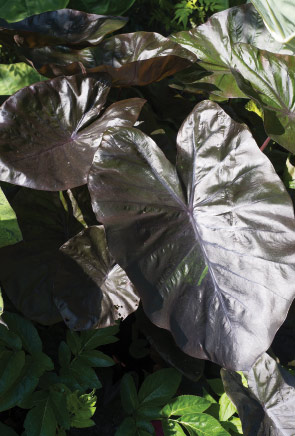The New Year stirs gardeners’ souls to plan and prepare for yet another growing season, with thoughts mainly turning to searching for eye-catching plants that will create instant new excitement among their beds and rows. If you are such a winter dreamer and want to try something completely different, consider going to the Dark Side this year.
There is no evil intent here. In this case, the Dark Side means plants with foliage colors that forego the typical greens in favor of hues from the deepest shadows. Their usefulness goes beyond creating a Goth garden that neighbors will surely gab about — such dusky plants can poke playful black holes in summer landscapes that are typically overcome with underwhelming green, green and more green. These night-colored beauties can also serve as background canvas to bright summer flowers so they will visually pop even more.
Listed below are just four of the many good reasons to be tempted by the Dark Side. Although these plants are abnormally absent of green, they are not normally hard to find at garden centers in the spring.
- Purple Heart (Tradescantia pallida). As a low-growing, crawling plant, it will quickly spread into a swath of pretty purple, even in the worst summer heat. This lady might look shady, but she loves the sun — the more it gets, the darker its foliage becomes. It will also produce tri-cornered pink flowers that come and go throughout the growing season. This tough plant is a tried-and-true standard in many commercial landscapes, and for home gardeners, it is also a good candidate for water-conserving xeriscape plantings as well as hanging baskets.
- Ornamental Sweet Potato (Ipomoea batatas). There have been many shadowy introductions of this popular landscape vine, from the dependable ‘Ace of Spades’ and ‘Sweetheart Purple’ to the deeply lobed ‘Blackie’, ‘Sweet Caroline Raven’ and ‘Illusion Midnight Lace’. Any of these dusky beauties can easily crawl over and cover up space in need of an antidote against an all-green landscape. These pretty cousins of the edible sweet potato are another favorite of professional landscapers.
- Pennisetum (Pennisetum sp.). Yes, this popular, dependable ornamental grass has a dark side — in a good way, of course — as there are several cultivars available to add an interesting otherworld element to ordinary summer garden beds. Need examples? ‘Princess Caroline’ and ‘Rubrum’ will punch shady holes in a sunlit landscape setting with 3-foot mounds of deep purple foliage, while the equally inky ‘Princess’ tops out at around 4 feet. Want bigger? The aptly named ‘Purple Majesty’ stretches to 5 feet high, and ‘Prince’ will cast 6-foot-tall shadows over a garden. This is yet another group of easy-to-care-for, desirable dark plants often used by landscape companies.
- Taro (Colocasia esculenta). Also known as “elephant ears,” these plants with their huge, heart-shaped leaves can always be counted upon to bring an exotic touch to any garden. And with some cultivars having foliage dipped deeply in inky hues, “exotic” becomes delightfully mysterious. ‘Midnight’ and ‘Black Beauty’, both of which grow 3 to 4 feet high, have been popular cultivars recently, but also consider casting a deeper spell with the 5-foot-tall ‘Black Magic’. And the closely related ‘Black Runner’ has the same size and simmering look of ‘Black Magic’, but its leaves are a bit more ruffled on the edges. ‘Black Coral’ has ruffles as well, but they are nicely accentuated with a glimmering gloss. Taros are also used by commercial landscapers, but for the best displays, remember that these botanical beauties are heavy feeders and prefer moist soil during the growing season.
To Do in the Garden
January
- Don’t kick the Christmas tree to the curb just yet. Set it up in the backyard as a wild bird haven and make it more hospitable to your winged friends by redecorating with seed bells, suet bars and strings of edible berries.
- Thinking about having your any of your garden power equipment tuned up? Avoid the spring rush at small engine shops, and take care of this task now.
- Shrubs and small trees that were root pruned last fall can be transplanted starting at the end of the month.
- To prevent damage to branches, brush snow off of evergreens as soon as possible. Fresh snow is easily removed, while snow that is allowed to refreeze stubbornly clings to foliage.
- Turn the soil over in your annual beds. This dirt digging will expose overwintering insects and insect eggs to the killing cold and hungry birds.
- Now is not too soon to begin ordering plant seeds from garden catalogs and online sources.
- If the southerly windows of your home are filled with sun-loving house plants, make sure their leaves don’t touch the glass panes at this time of year. On especially cold nights, glass-hugging foliage of tender plants could be damaged.
- Exclusive Dish: Chicken Tortilla Soup at Los Tres Magueyes
- Just Add Color
- Brown Bag Ministry – The 2015 Cary Magazine Gives Back Charity Partner
- The Best from the Dark Side
- Taking Off: Aviator Brewery
- Best Place to Get a Cocktail & Best Appetizers
- Best Bakery & Best Food Truck & Best Coffeehouse
- Best New Restaurant
- Best Charity
- Best High School Principal & Best High School Coach
- Best Elementary School Principal
- Best Middle School Principal
- Best Home Service
- Best Doctor
- Best Mechanic Shop
- Best New Business (Non-restaurant)
- Best TV Personality
- It’s Here Somewhere
- Hockey Scores With Area Youth
- 2015 Maggy Awards
- Real-Life Resolutions
- Best for a Special Occasion
- How To Buy a Coat
- Dreamfest 2015
- Life & Legacy: A Celebration







